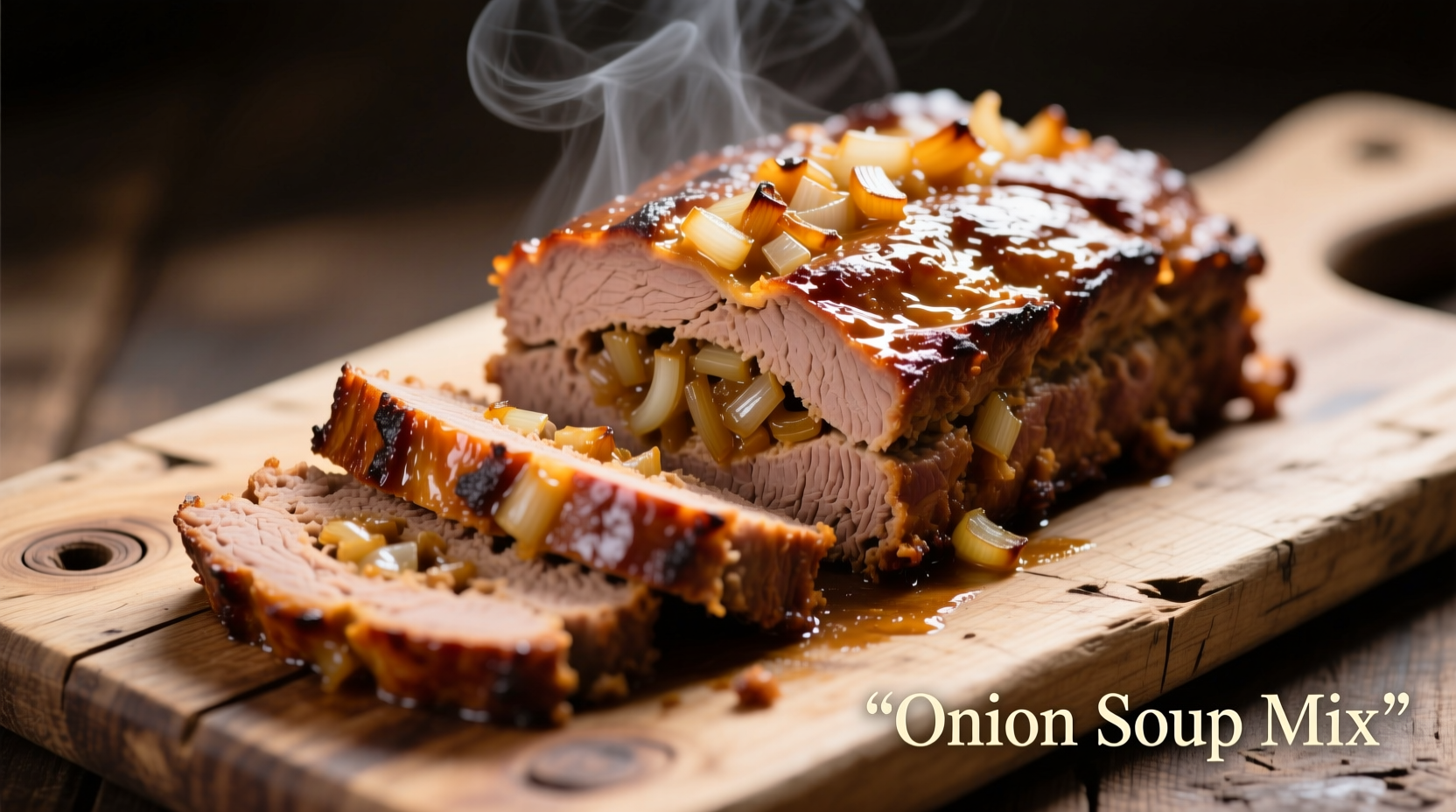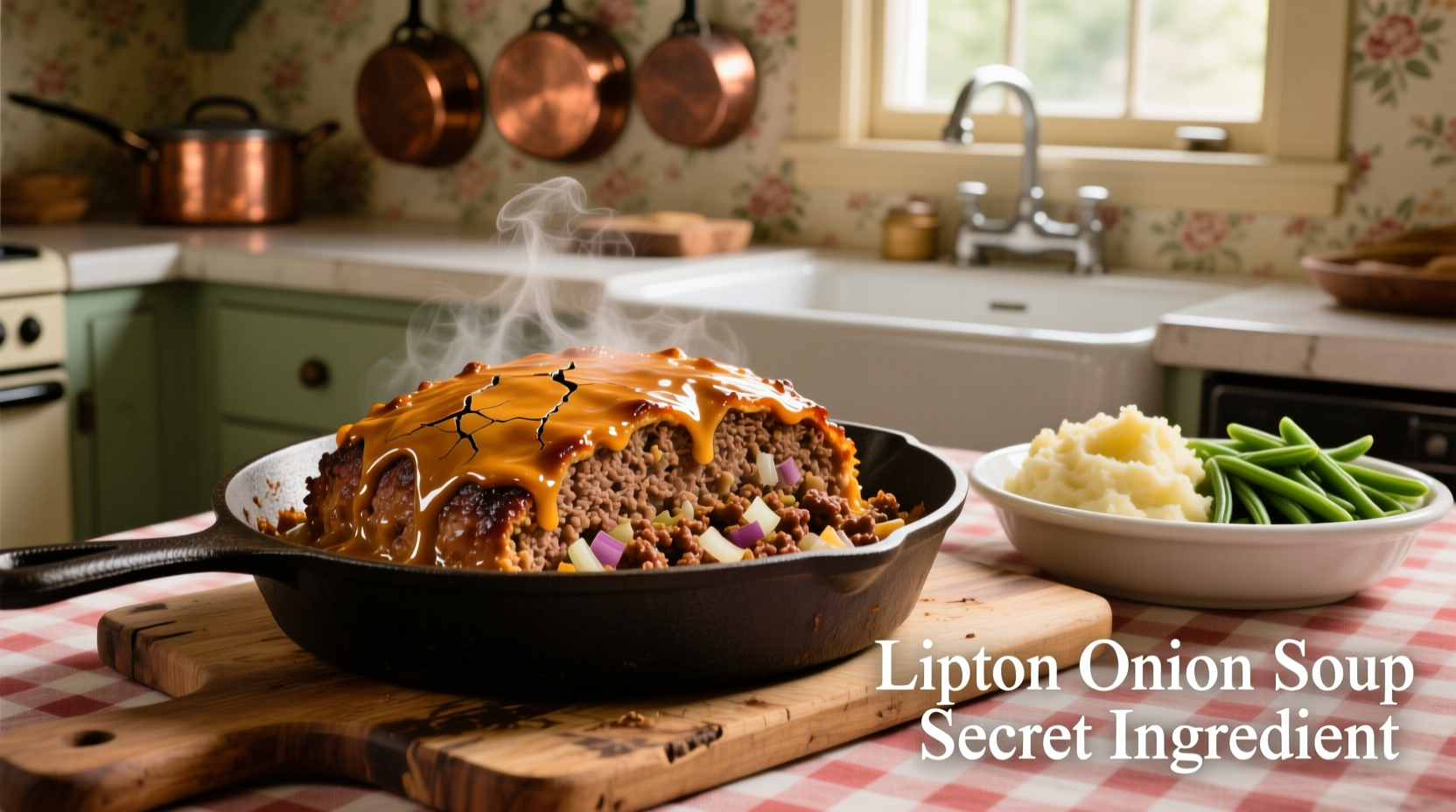For decades, home cooks have relied on Lipton onion soup mix to transform ordinary meatloaf into something extraordinary. This humble packet does more than just add flavor—it creates a tender texture, locks in moisture, and builds complex savory notes that elevate your dish from basic to restaurant-quality. Let's explore why this kitchen shortcut works so well and how to maximize its potential.
Why Lipton Onion Soup Mix Works Perfectly for Meatloaf
The magic happens through three key mechanisms: the dehydrated onions rehydrate during cooking to create natural moisture pockets, the seasoning blend contains hydrolyzed proteins that enhance umami, and the small amount of oil in the mix prevents the meat from becoming dense. According to USDA food safety guidelines, maintaining proper moisture content in ground meat dishes is crucial for both texture and safety—undercooked dry meatloaf often requires extended cooking that leads to toughness.
| Ingredient Function | Traditional Approach | Lipton Soup Mix Advantage |
|---|---|---|
| Moisture retention | Eggs, breadcrumbs, milk | Dehydrated onions rehydrate gradually during cooking |
| Flavor development | Individual seasonings | Balanced blend of onion, garlic, herbs, and umami enhancers |
| Texture improvement | Multiple binders required | Single ingredient provides both moisture and binding |
Your Essential Meatloaf Timeline: From 1940s Pantry Staple to Modern Classic
The Lipton onion soup mix meatloaf tradition began in the 1940s when home economists discovered the dehydrated onion flakes created superior texture compared to fresh onions. During World War II rationing, this method gained popularity as it required fewer fresh ingredients. By the 1950s, it appeared in Betty Crocker cookbooks as a "modern" technique. Today, food scientists at institutions like Cornell University's Food Science Department confirm that the controlled dehydration process preserves flavor compounds better than fresh onions for cooked applications.
Gathering Your Ingredients: What You'll Need
For a standard 2-pound meatloaf that serves 6-8 people:
- 1 package (1 oz) Lipton Recipe Secrets Onion Soup Mix
- 2 lbs ground beef (80% lean recommended)
- 1 large egg
- ⅓ cup milk
- ½ cup breadcrumbs
- 2 tablespoons ketchup (plus extra for topping)
- 1 teaspoon Worcestershire sauce
Pro Tip: For optimal results, choose ground beef with 20% fat content. USDA research shows this fat ratio creates the ideal moisture balance in cooked meatloaf while maintaining food safety standards.
Step-by-Step Preparation Guide
- Mix dry ingredients: In a large bowl, combine the Lipton onion soup mix, breadcrumbs, and a pinch of black pepper
- Create wet mixture: Whisk together egg, milk, ketchup, and Worcestershire sauce
- Combine gently: Add ground beef to both mixtures and blend using your hands—avoid overmixing which causes toughness
- Shape properly: Form into a loaf on a parchment-lined baking sheet (not in a pan) for even cooking
- Apply glaze: Spread 2 tablespoons ketchup over the top
- Cook precisely: Bake at 375°F for 45-55 minutes until internal temperature reaches 160°F
Avoiding Common Meatloaf Mistakes
Even experienced cooks encounter these issues when using soup mix:
- Too salty? Reduce added salt elsewhere in your recipe—the soup mix contains sufficient sodium
- Dry texture? Ensure you're using 80% lean ground beef and don't overbake past 160°F
- Falling apart? Don't skip the egg and breadcrumbs—even with the soup mix, binders are essential
- Bland flavor? Add 1 teaspoon smoked paprika to enhance the soup mix's natural depth
Serving and Storage Recommendations
Let your meatloaf rest for 10 minutes before slicing—this allows the juices to redistribute. For meal prep success, slice leftovers into portions and store in airtight containers. According to FoodSafety.gov, cooked meatloaf remains safe for 3-4 days in the refrigerator or up to 3 months frozen. When reheating, add a splash of beef broth to maintain moisture.

Variations to Try Next Time
Once you've mastered the classic version, experiment with these professional chef techniques:
- Italian twist: Add ¼ cup grated Parmesan and 1 teaspoon dried oregano
- Southwest style: Mix in 1 diced chipotle pepper and ½ cup corn
- Mushroom upgrade: Sauté ½ cup mushrooms and replace half the soup mix with them
- Gluten-free option: Use almond flour instead of breadcrumbs
Frequently Asked Questions
Can I use low-sodium Lipton onion soup mix for meatloaf?
Yes, but you'll need to add ½ teaspoon additional salt to compensate for the flavor depth lost in low-sodium versions. The regular version provides better umami development due to its complete seasoning profile.
How do I prevent my meatloaf from becoming too dense?
The critical step is avoiding overmixing. Combine ingredients just until incorporated—about 30 seconds of gentle mixing. Also, baking on a flat sheet rather than in a loaf pan allows better heat circulation and prevents steaming.
Can I make this recipe ahead of time?
Absolutely. Prepare the meatloaf through step 4, cover tightly, and refrigerate for up to 24 hours before baking. You may need to add 5-10 minutes to the cooking time if starting from cold.
Why does my meatloaf sometimes fall apart when slicing?
This usually happens when the meatloaf hasn't rested sufficiently. Allow at least 10 minutes for the proteins to set after cooking. Also ensure you're using the recommended 1 egg per 2 pounds of meat as a binder.











 浙公网安备
33010002000092号
浙公网安备
33010002000092号 浙B2-20120091-4
浙B2-20120091-4